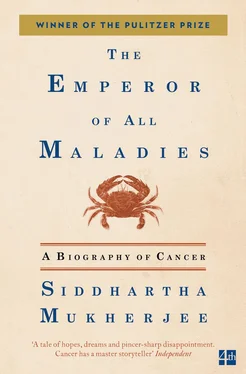Farber’s specialty was pediatric pathology 11, the study of children’s diseases. He had spent nearly twenty years in these subterranean rooms staring obsessively down his microscope and climbing through the academic ranks to become chief of pathology at Children’s. But for Farber, pathology was becoming a disjunctive form of medicine, a discipline more preoccupied with the dead than with the living. Farber now felt impatient watching illness from its sidelines, never touching or treating a live patient. He was tired of tissues and cells. He felt trapped, embalmed in his own glassy cabinet.
And so, Farber had decided to make a drastic professional switch. Instead of squinting at inert specimens under his lens, he would try to leap into the life of the clinics upstairs—from the microscopic world that he knew so well into the magnified real world of patients and illnesses. He would try to use the knowledge he had gathered from his pathological specimens to devise new therapeutic interventions. The parcel from New York contained a few vials of a yellow crystalline chemical named aminopterin. It had been shipped to his laboratory in Boston on the slim hope that it might halt the growth of leukemia in children.

Had Farber asked any of the pediatricians circulating in the wards above him about the likelihood of developing an antileukemic drug, they would have advised him not to bother trying. Childhood leukemia had fascinated, confused, and frustrated doctors for more than a century. The disease had been analyzed, classified, subclassified, and subdivided meticulously; in the musty, leatherbound books on the library shelves at Children’s—Anderson’s Pathology or Boyd’s Pathology of Internal Diseases—page upon page was plastered with images of leukemia cells and appended with elaborate taxonomies to describe the cells. Yet all this knowledge only amplified the sense of medical helplessness. The disease had turned into an object of empty fascination—a wax-museum doll—studied and photographed in exquisite detail but without any therapeutic or practical advances. “It gave physicians plenty to wrangle over 12at medical meetings,” an oncologist recalled, “but it did not help their patients at all.” A patient with acute leukemia was brought to the hospital in a flurry of excitement, discussed on medical rounds with professorial grandiosity, and then, as a medical magazine drily noted, “diagnosed, transfused—and sent home to die.” 13
The study of leukemia had been mired in confusion and despair ever since its discovery. On March 19, 1845, a Scottish physician, John Bennett, had described an unusual case, a twenty-eight-year-old slate-layer with a mysterious swelling in his spleen. “He is of dark complexion,” 14Bennett wrote of his patient, “usually healthy and temperate; [he] states that twenty months ago, he was affected with great listlessness on exertion, which has continued to this time. In June last he noticed a tumor in the left side of his abdomen which has gradually increased in size till four months since, when it became stationary.”
The slate-layer’s tumor might have reached its final, stationary point, but his constitutional troubles only accelerated. Over the next few weeks, Bennett’s patient spiraled from symptom to symptom—fevers, flashes of bleeding, sudden fits of abdominal pain—gradually at first, then on a tighter, faster arc, careening from one bout to another. Soon the slate-layer was on the verge of death with more swollen tumors sprouting in his armpits, his groin, and his neck. He was treated with the customary leeches and purging, but to no avail. At the autopsy a few weeks later, Bennett was convinced that he had found the reason behind the symptoms. His patient’s blood was chock-full of white blood cells. (White blood cells, the principal constituent of pus, typically signal the response to an infection, and Bennett reasoned that the slate-layer had succumbed to one.) “The following case seems to me particularly valuable,” he wrote self-assuredly, “as it will serve to demonstrate the existence of true pus, formed universally within the vascular system.”*
It would have been a perfectly satisfactory explanation except that Bennett could not find a source for the pus. During the necropsy, he pored carefully through the body, combing the tissues and organs for signs of an abscess or wound. But no other stigmata of infection were to be found. The blood had apparently spoiled—suppurated—of its own will, combusted spontaneously into true pus. “A suppuration of blood,” Bennett called his case. And he left it at that.
Bennett was wrong, of course, about his spontaneous “suppuration” of blood. A little over four months after Bennett had described the slater’s illness, a twenty-four-year-old German researcher, Rudolf Virchow, independently published 16a case report with striking similarities to Bennett’s case. Virchow’s patient was a cook in her midfifties. White cells had explosively overgrown her blood, forming dense and pulpy pools in her spleen. At her autopsy, pathologists had likely not even needed a microscope to distinguish the thick, milky layer of white cells floating above the red.
Virchow, who knew of Bennett’s case, couldn’t bring himself to believe Bennett’s theory. Blood, Virchow argued, had no reason to transform impetuously into anything. Moreover, the unusual symptoms bothered him: What of the massively enlarged spleen? Or the absence of any wound or source of pus in the body? Virchow began to wonder if the blood itself was abnormal. Unable to find a unifying explanation for it, and seeking a name for this condition 17, Virchow ultimately settled for weisses Blut—white blood—no more than a literal description of the millions of white cells he had seen under his microscope. In 1847, he changed the name to the more academic-sounding “leukemia”—from leukos, the Greek word for “white.”

Renaming the disease—from the florid “suppuration of blood” to the flat weisses Blut—hardly seems like an act of scientific genius, but it had a profound impact on the understanding of leukemia. An illness, at the moment of its discovery, is a fragile idea, a hothouse flower—deeply, disproportionately influenced by names and classifications. (More than a century later, in the early 1980s, another change in name 18—from gay related immune disease (GRID) to acquired immuno deficiency syndrome (AIDS)—would signal an epic shift in the understanding of that disease.*) Like Bennett, Virchow didn’t understand leukemia. But unlike Bennett, he didn’t pretend to understand it. His insight lay entirely in the negative. By wiping the slate clean of all preconceptions, he cleared the field for thought.
The humility of the name (and the underlying humility about his understanding of cause) epitomized Virchow’s approach to medicine 19. As a young professor at the University of Würzburg, Virchow’s work soon extended far beyond naming leukemia. A pathologist by training, he launched a project that would occupy him for his life: describing human diseases in simple cellular terms.
It was a project born of frustration. Virchow entered medicine in the early 1840s, when nearly every disease was attributed to the workings of some invisible force: miasmas, neuroses, bad humors, and hysterias. Perplexed by what he couldn’t see, Virchow turned with revolutionary zeal to what he could see: cells under the microscope. In 1838, Matthias Schleiden, a botanist, and Theodor Schwann, a physiologist, both working in Germany, had claimed that all living organisms were built out of fundamental building blocks called cells. Borrowing and extending this idea, Virchow set out to create a “cellular theory” of human biology, basing it on two fundamental tenets. First, that human bodies (like the bodies of all animals and plants) were made up of cells. Second, that cells only arose from other cells—omnis cellula e cellula, as he put it.
Читать дальше













